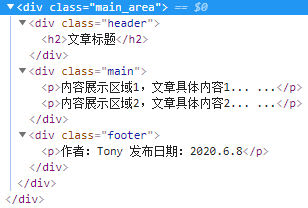(1)插槽内容
Vue 实现了一套内容分发的 API,这套 API 的设计灵感源自 Web Components 规范草案,将 <slot> 元素作为承载分发内容的出口。
在父级组件里可以这样写
<div class="slot_area"> <navigation-link v-bind:url="url"> Your Profile你的个人简介资料 </navigation-link> </div>
然后在 <navigation-link> 组件模板中:
Vue.component('navigation-link',{ props:['url'], template:`<a v-bind:href="url" class="nav-link"> <span class="slot_span"></span> <slot></slot> </a>` });
new Vue({
el:'.slot_area',
data:{
url:'http://www.baidu.com'
}
})
当组件渲染的时候,<slot></slot> 将会被替换为“Your Profile你的个人简介资料”。

插槽内可以包含任何模板代码,包括 HTML:
Vue.component('navigation-link',{
props:['url'],
template:`<a v-bind:href="url" class="nav-link">
<!-- 添加一个 Font Awesome 图标 -->
<span class="fa fa-user"></span>
<slot></slot>
</a>`
});

插槽也可以是其他组件
<div class="slot_area"> <navigation-link v-bind:url="url"> Your Profile你的个人资料简介 <slot-component></slot-component> </navigation-link> </div> <script type="text/javascript"> Vue.component('navigation-link',{ props:['url'], template:`<a v-bind:href="url" class="nav-link"> <!-- 添加一个 Font Awesome 图标 --> <span class="slot_span"></span> <slot></slot> </a>` }); Vue.component('slot-component',{ template:'<h4>插槽可以是其他模板</h4>' }) new Vue({ el:'.slot_area', data:{ url:'http://www.baidu.com' } }) </script>
结果:


注意:如果 <navigation-link> 没有包含一个 <slot> 元素,则该组件起始标签和结束标签之间的任何内容都会被抛弃。即如果模板中没有slot插槽元素,则在父级组件里加的内容都会被抛弃。
(2)编译作用域
父组件模板内容是在父组件作用域中编译的,子组件模板内容是在子组件里编译的。
先来个简单的案例:
<parent-scrop>
{{message}}
</parent-scrop>
Vue.component('parent-scrop',{ template:`<div> 子组件模板内容 <slot></slot> </div>` }); new Vue({ el:".parent_scrop", data:{ message:"父组件模板内容" } });
这里的message就是一个slot,但是其绑定的是父组件的数据,而不是子组件模板的数据。
再来看个案例:
<div class="parent_scrop"> <parent-scrop v-show="showStatus"></parent-scrop> </div> Vue.component('parent-scrop',{ template:`<div> 子组件模板内容 </div>` }); new Vue({ el:".parent_scrop", data:{ showStatus:true } })
这里的showStatus绑定的是父级组件的数据,如果想在子级组件上绑定,应该是
<div class="parent_scrop"> <parent-scrop></parent-scrop> </div> Vue.component('parent-scrop',{ template:`<div v-show="showStatus"> 子组件模板内容 </div>`, data:function(){ return { showStatus:false } } }); new Vue({ el:".parent_scrop" })
结果:

因此,slot分发的内容,作用域是在父组件上的。
(3)slot用法
①单个slot
在子组件内使用特殊的<slot>元素就可以为这个子组件开启一个slot(插槽),在父组件模板里,插入在父组件标签内的所有内容都将替代子组件的<slot>标签及它的内容。
demo1:
<div class="single_slot"> <single-slot></single-slot> </div> Vue.component('single-slot',{ template:` <div> <slot> <p>如果父组件没有插入内容,将会作为默认值出现</p> </slot> </div> ` }); new Vue({ el:".single_slot" })
结果:

demo2:父组件插入内容
<div class="single_slot"> <single-slot> <p>父组件插入内容</p> <p>分发更多内容</p> </single-slot> </div> Vue.component('single-slot',{ template:` <div> <slot> <p>如果父组件没有插入内容,将会作为默认值出现</p> </slot> </div> ` }); new Vue({ el:".single_slot" })
结果:


(4)后备内容/备用内容
结合上例,<single-slot>模板里定义了<slot>元素,并用了<p>作为默认内容。在父组件没有使用slot即未插入内容时,会渲染这段默认文本;如果写入了slot,那么就会替换整个<slot>。
注意:子组件<slot>中的后备内容,其作用域是子组件本身。
(5)具名插槽
给<slot>元素指定一个name后,可以分发多个内容,具名插槽可以与单个插槽共存。
用法简单demo1:
父级组件里: <solt-area> <h2 slot="header">标题</h2> <p slot="footer">底部</p> </slot-area> 子级模板里: Vue.component('slot-area',{ template:` <div class="main_area"> <div class="header"><slot name="header"></slot></div> <div class="footer"><slot name="footer"></slot></div> </div> ` })
demo2:
<!-- 具名slot -->
<div class="slot_name">
<slot-name>
<h2 slot="header">文章标题</h2>
<p>内容展示区域1,文章具体内容1... ...</p>
<p>内容展示区域2,文章具体内容2... ...</p>
<p slot="footer">作者:Tony 发布日期:2020.6.8</p>
</slot-name>
</div>
<style type="text/css">
.main_area{
padding: 20px;
background-color: rgba(0,0,0,0.1);
}
.main_area h2{
margin: 10px 0;
text-align: center;
}
.main_area .footer{
text-align: right;
font-weight: 600;
margin: 10px 0;
}
.main_area .main{
padding: 10px;
background-color: rgba(0,0,0,.1);
}
</style>
/* 3、具名slot */
Vue.component('slot-name',{
template:`
<div class="main_area">
<div class="header"><slot name="header"></slot></div>
<div class="main"><slot></slot></div>
<div class="footer"><slot name="footer"></slot></div>
</div>
`
})
new Vue({
el:".slot_name"
})
结果:


子组件里声明了3个<slot>元素,其中在<div class="main"></div>内的slot没有使用name特性,所以他将作为默认slot出现,父组件里没有使用slot特性的元素与内容都将出现在这里。
如果没有指定默认的匿名slot,父组件里多余的内容片段都将会被抛弃。在组合使用组件时,内容分发API至关重要。
注意:自2.6.0开始有所跟新,将原先的slot方法更新为v-slot 指令即
<div class="slot_name"> <slot-name> <template v-slot:header> <h2>文章标题</h2> </template> <template v-slot:default> <p>内容展示区域1,文章具体内容1... ...</p> <p>内容展示区域2,文章具体内容2... ...</p> </template> <template v-slot:footer> <p>作者:Tony 发布日期:2020.6.8</p> </template> </slot-name> </div>
现在 <template> 元素中的所有内容都将会被传入相应的插槽。任何没有被包裹在带有 v-slot 的 <template> 中的内容都会被视为默认插槽的内容。然而,如果你希望更明确一些,仍然可以在一个 <template> 中包裹默认插槽的内容,如上所示v-slot:default。
(6)作用域插槽
正常情况下,父级组件的插槽内容无法访问子级模板中的数据,例如
<div class="scrop_slot"> <scrop-slot> 姓:{{user.firstName}},名:{{user.lastName}} </scrop-slot> </div> /* 4、作用域插槽 */ Vue.component('scrop-slot',{ template:` <div class="show_area"> <slot> <p>姓:{{user.firstName}},名:{{user.lastName}}</p> </slot> </div> `, data:function(){ return { user:{firstName:"邓",lastName:"超"} }; } }) new Vue({ el:".scrop_slot" }) /* 4、作用域插槽 */
此时,控制台会出现报错提示

为了让 user 在父级的插槽内容可用,我们可以将 user 作为一个 <slot> 元素的特性绑定上去:
<slot v-bind:user="user">
<p>姓:{{user.firstName}},名:{{user.lastName}}</p>
</slot>
绑定在 <slot> 元素上的特性被称为插槽 prop。现在在父级作用域中,我们可以给 v-slot 带一个值来定义我们提供的插槽 prop 的名字:
<div class="scrop_slot"> <scrop-slot v-slot:default="slotDefault"> <template> 姓:{{slotDefault.user.firstName}},名:{{slotDefault.user.lastName}} </template> </scrop-slot> </div>
在这个例子中,选择将包含所有插槽 prop 的对象命名为 slotProps,也可以使用任意你喜欢的名字。
(7)独占默认插槽的缩写语法
<div class="scrop_slot"> <scrop-slot v-slot:default="slotDefault"> <template> 姓:{{slotDefault.user.firstName}},名:{{slotDefault.user.lastName}} </template> </scrop-slot> </div>
在上述情况下,当被提供的内容只有默认插槽时,组件的标签才可以被当作插槽的模板来使用。这样我们就可以把 v-slot 直接用在组件上:
<div class="scrop_slot"> <scrop-slot v-slot:default="slotDefault"> 姓:{{slotDefault.user.firstName}},名:{{slotDefault.user.lastName}} </scrop-slot> </div>
这种写法还可以更简单。就像假定未指明的内容对应默认插槽一样,不带参数但 v-slot 被假定对应默认插槽:
<div class="scrop_slot"> <scrop-slot v-slot="slotDefault"> 姓:{{slotDefault.user.firstName}},名:{{slotDefault.user.lastName}} </scrop-slot> </div>
注意:注意默认插槽的缩写语法不能和具名插槽混用,因为它会导致作用域不明确。如下所示
<scrop-slot v-slot="slotDefault"> 姓:{{slotDefault.user.firstName}} <template v-slot:other="otherSlot"> 名:{{slotDefault.user.lastName}} </template> </scrop-slot>

此时,控制台出现报错:译为---为避免范围模糊,当存在其他命名槽时,默认槽也应使用<template>语法。
<scrop-slot>
<template v-slot:datault="slotDefault">
姓:{{slotDefault.user.firstName}}
</template>
<template v-slot:other="otherSlot">
名:{{otherSlot.user.lastName}}
</template>
</scrop-slot>
只要出现多个插槽,请始终为所有的插槽使用完整的基于 <template> 的语法。
(8)解构插槽Prop
可以使用 ES2015 解构来传入具体的插槽 prop,如下:
<div class="scrop_slot"> <scrop-slot v-slot="{user}"> {{user.firstName}} </scrop-slot> </div> Vue.component('scrop-slot',{ template:` <div class="show_area"> <slot v-bind:user="user"> <p>姓:{{user.firstName}},名:{{user.lastName}}</p> </slot> </div> `, data:function(){ return { user:{firstName:"邓",lastName:"超"} }; } }) new Vue({ el:".scrop_slot" })
这样可以使模板更简洁,尤其是在该插槽提供了多个 prop 的时候。它同样开启了 prop 重命名等其它可能,例如将 user 重命名为 person:
<scrop-slot v-slot="{user:person}"> {{person.firstName}} </scrop-slot>
(9)动态插槽名(待验证)
(10)具名插槽缩写
跟 v-on 和 v-bind 一样,v-slot 也有缩写,即把参数之前的所有内容 (v-slot:) 替换为字符 #。例如 v-slot:header 可以被重写为 #header:
<div class="slot_name"> <slot-name> <template #header> <h2>文章标题</h2> </template> <template #default> <p>内容展示区域1,文章具体内容1... ...</p> <p>内容展示区域2,文章具体内容2... ...</p> </template> <template #footer> <p>作者:Tony 发布日期:2020.6.8</p> </template> </slot-name> </div>
.